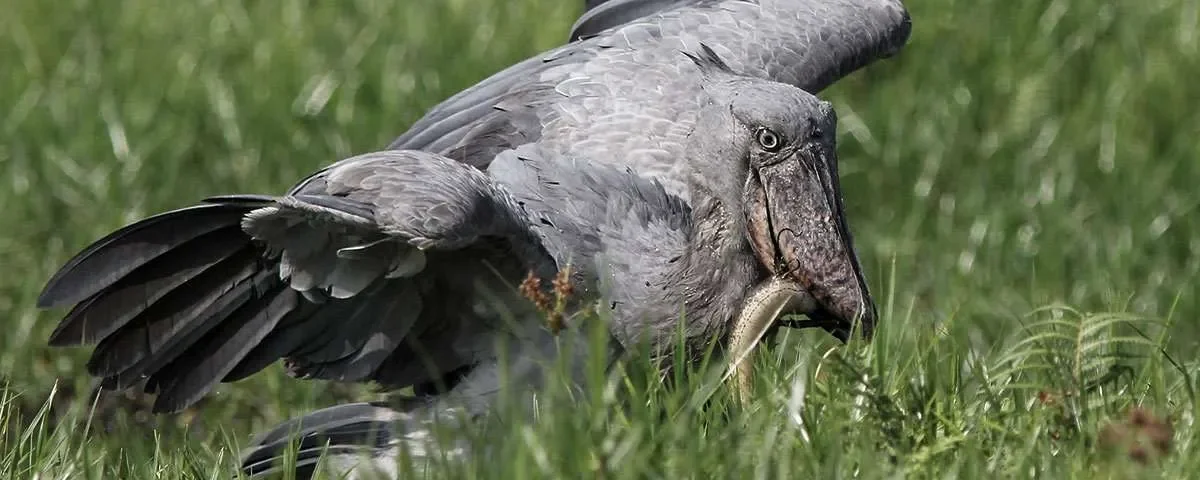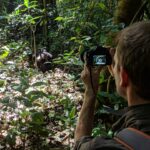
Can I Take Photos of Chimpanzees During Tracking?
September 24, 2025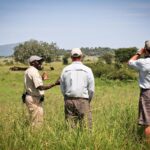
Can I Take Photos During a Walking Safari in Uganda?
September 24, 2025Can I See the Shoebill Stork in Uganda?
Can I see the shoebill stork in Uganda? This question fascinates bird enthusiasts and wildlife adventurers alike. The shoebill stork, scientifically known as Balaeniceps rex, is a rare and prehistoric-looking bird that has captured the imaginations of travelers worldwide. Known for its enormous shoe-shaped bill, piercing gaze, and silent hunting techniques, the shoebill is one of Uganda’s most iconic and sought-after species for birdwatchers. For those planning Uganda Safaris, spotting this elusive bird is a highlight that combines thrill, patience, and the unparalleled beauty of Uganda’s wetland ecosystems.
EcoQuest Safaris has curated specialized Uganda Birding Safaris that allow travelers to observe the shoebill in its natural habitat. But can I see the shoebill stork in Uganda safely and responsibly? The answer is yes — with proper guidance and expert local knowledge. Guided tours are designed to minimize disturbances to the bird’s environment while maximizing the chances of sightings. The experience is not just about seeing the bird; it’s an educational journey where guides share insights on wetland ecology, shoebill behavior, and conservation efforts.
Furthermore, seeing the shoebill stork can be seamlessly combined with Uganda Gorilla Trekking Safaris, Uganda Chimpanzee Safaris, or broader Uganda Wildlife Safaris. This combination creates a multi-layered adventure, allowing travelers to witness both the wetlands and forests, primates, and diverse wildlife, making it one of Uganda’s Best Safaris for nature enthusiasts.
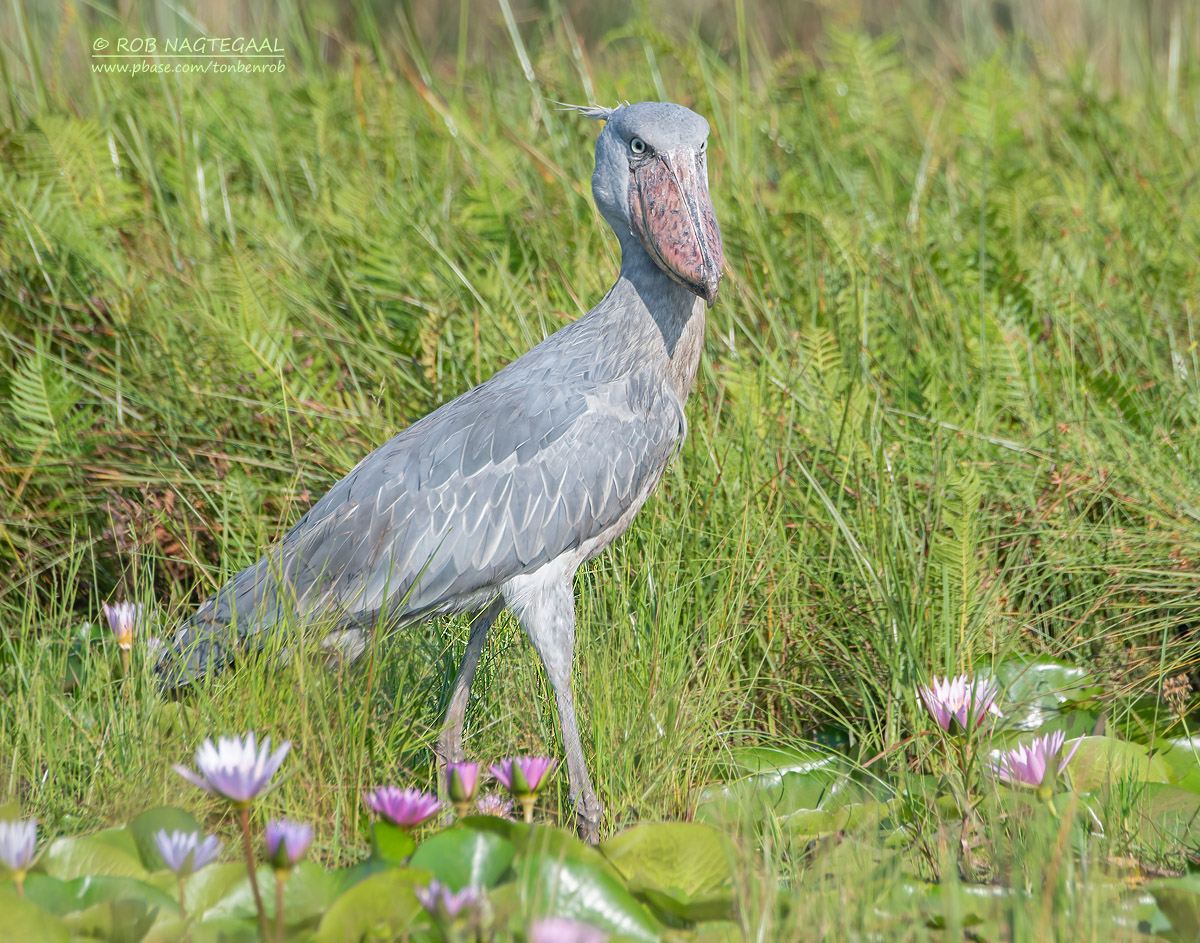
Bird Watching Safaris
Where Can I Spot the Shoebill Stork in Uganda?
Can I see the shoebill stork in Uganda, and where are the best locations? Uganda is one of the few countries in Africa where the shoebill can reliably be seen, primarily in its extensive freshwater swamps and marshes. The most renowned site is Mabamba Swamp, located on the western shores of Lake Victoria, which is recognized as a top destination for Uganda Birding Safaris. This swamp offers a labyrinth of channels, reed beds, and papyrus marshes where shoebills hunt for lungfish, catfish, and other wetland prey.
Other notable sites include Bugungu and Hima Wetlands, often integrated into Uganda Wildlife Safaris itineraries. These wetlands are ideal for combining birding with general wildlife viewing, offering sightings of hippos, crocodiles, and other waterbirds. Travelers often ask, can I see the shoebill stork in Uganda on a single-day trip? Yes, guided tours from Entebbe or Kampala can offer early morning excursions, which is the optimal time since shoebills are most active at dawn.
For those seeking Uganda Best Safaris experiences, shoebill sightings can also be combined with Uganda Cultural Safaris. Nearby fishing villages provide insights into the local communities’ lives, their dependence on wetlands, and how conservation initiatives help protect both the bird and the people. EcoQuest Safaris ensures these excursions are conducted responsibly, balancing thrilling wildlife encounters with community engagement.
How Do I Maximize My Chances of Seeing the Shoebill Stork?
Can I see the shoebill stork in Uganda reliably, and how do I increase my chances? Observing the shoebill requires patience, the right equipment, and expert guidance. EcoQuest Safaris provides experienced guides who know the specific shoebill hotspots and the subtle signs of its presence. Guests are often advised to use binoculars, wear muted clothing, and remain quiet while navigating the papyrus channels in small, non-motorized boats.
Timing also matters. Can I see the shoebill stork in Uganda throughout the year? While sightings are possible year-round, the dry season between December and February, and the wet season from June to September, offer optimal conditions. These periods coincide with low water levels, making the shoebill more visible in the shallow swamps while they hunt more actively in concentrated areas.
What about combining birding with other safari activities? Walking along the fringes of wetlands can be integrated into Uganda Wildlife Safaris or Uganda Birding Safaris, offering opportunities to see marshland species, monitor animal tracks, and enjoy guided educational walks. For adventure travelers, it’s possible to combine a shoebill-focused safari with Uganda Gorilla Trekking Safaris in Bwindi or Mgahinga. This blend allows for a seamless journey from wetland ecosystems to dense tropical forests, providing a holistic view of Uganda’s biodiversity.
Are Shoebill Stork Tours Safe for Travelers?
Can I see the shoebill stork in Uganda safely? Yes, when tours are organized by reputable safari operators like EcoQuest Safaris. Guided excursions follow strict safety protocols to ensure that travelers navigate swampy terrain and waterways without risk. Boats used for observation are stable, and guides are trained in first aid, wildlife behavior, and navigation of complex marshland ecosystems.
Walking near wetlands may raise questions about encounters with crocodiles, snakes, or other wildlife. Are shoebill stork tours safe in Uganda? Absolutely, because guides are knowledgeable about potential hazards and maintain safe distances from both wildlife and sensitive habitats. Furthermore, tours are conducted in small groups, ensuring personalized attention and controlled movement in delicate ecosystems.
These precautions make Uganda Birding Safaris, which focus on the shoebill stork, not only safe but also highly educational. Guides explain how the shoebill hunts, how it interacts with other wetland species, and the conservation measures in place to protect this vulnerable bird. Travelers can feel confident that they are observing one of Africa’s rarest species responsibly while contributing to ongoing preservation efforts.
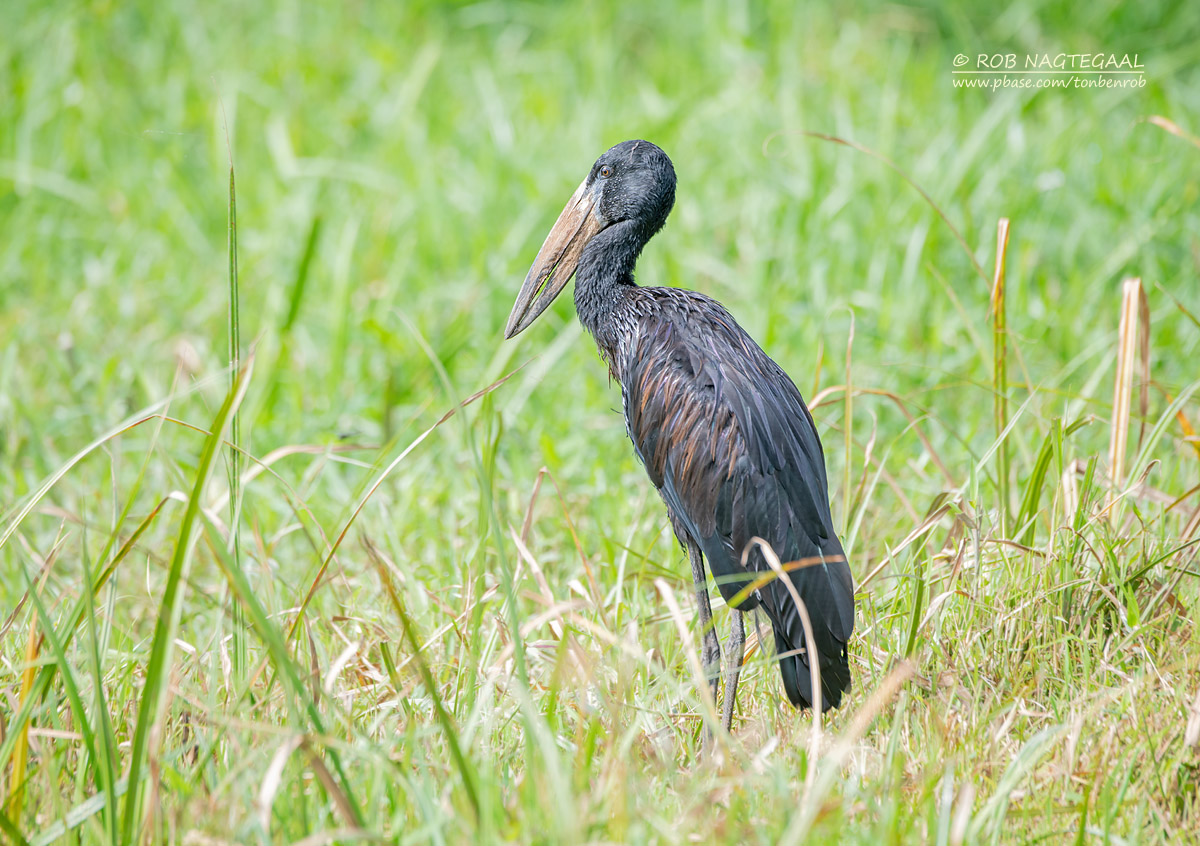 How Can Walking Safaris Enhance Shoebill Sightings?
How Can Walking Safaris Enhance Shoebill Sightings?
Can I see the shoebill stork in Uganda during a walking safari? Yes, walking safaris offer a unique perspective for birdwatching in Uganda. By carefully navigating along marsh edges, boardwalks, or shallow channels, travelers can observe shoebills up close without disturbing their natural behavior. Walking tours also provide opportunities to see smaller wetland species, study aquatic plants, and understand the intricate ecosystem of Uganda’s swamps.
EcoQuest Safaris often combines walking safaris with Uganda Cultural Safaris, enabling travelers to engage with local communities living near the wetlands. This includes visiting fishing villages, observing traditional fishing methods, and learning how conservation initiatives help both wildlife and people. Can I see the shoebill stork in Uganda and interact with communities on the same safari? Yes, guided walking tours facilitate this dual experience safely and responsibly.
Combining walking safaris with Uganda Gorilla Trekking Safaris or Uganda Chimpanzee Safaris allows for a more comprehensive Uganda Best Safaris experience. Travelers can start the day in tranquil marshes watching shoebills and other wetland birds, then continue into lush forests tracking primates. This combination creates an unparalleled adventure that caters to birders, wildlife enthusiasts, and cultural explorers alike.
Where Else in Uganda Can I Combine Shoebill Sightings with Wildlife?
Can I see the shoebill stork in Uganda and also enjoy other wildlife experiences? Yes, wetlands can easily be integrated into broader Uganda Wildlife Safaris. For example, Mabamba Swamp tours can be combined with Lake Victoria boat safaris or nearby park visits such as Murchison Falls, Queen Elizabeth, or Lake Mburo. These itineraries allow travelers to witness a variety of species, from shoebills and herons to elephants, lions, and giraffes.
Birding-focused walks can also reveal Uganda’s diverse wetland birds, including papyrus gonoleks, African finfoots, and malachite kingfishers. Are these tours suitable for families and beginners? Absolutely — small, guided groups, slow-paced walks, and expert commentary make Uganda Birding Safaris accessible to all skill levels while keeping the shoebill and other wildlife undisturbed.
Furthermore, combining shoebill sightings with Uganda Gorilla Trekking Safaris in Bwindi or Mgahinga adds a rainforest dimension to the journey. Visitors can experience wetlands and primate-rich forests in a single trip, making Uganda Safaris one of the most diverse and rewarding wildlife adventures in Africa.
Why Book Shoebill Stork Safaris with EcoQuest Safaris?
Can I see the shoebill stork in Uganda reliably, and why should I book with EcoQuest Safaris? EcoQuest Safaris offers unmatched expertise in Uganda Birding Safaris, ensuring travelers enjoy secure, legal, and informative excursions. Guides have intimate knowledge of shoebill habitats, peak sighting times, and ecological patterns, significantly increasing the chances of sightings.
Additionally, EcoQuest Safaris integrates cultural experiences, community visits, and multi-activity safaris. Can I see the shoebill stork in Uganda and also trek gorillas or chimpanzees on the same trip? Yes — EcoQuest Safaris designs itineraries that blend Uganda Gorilla Trekking Safaris, Uganda Chimpanzee Safaris, Uganda Wildlife Safaris, and Uganda Cultural Safaris for a well-rounded experience. Safety, environmental responsibility, and guest satisfaction remain top priorities, making the adventure both memorable and secure.
Booking through EcoQuest Safaris also ensures that all permits, park fees, and logistical arrangements are handled in advance. This removes stress for travelers and allows you to focus entirely on enjoying Uganda’s extraordinary wildlife, culture, and landscapes.
Conclusion: Can I See the Shoebill Stork in Uganda?
So, can I see the shoebill stork in Uganda? The answer is a confident yes. With expert guidance, careful planning, and adherence to conservation protocols, witnessing this rare bird becomes one of the highlights of Uganda Safaris. Whether through Uganda Birding Safaris, walking tours, or integrated wildlife and cultural experiences, travelers can enjoy safe and rewarding encounters with the shoebill while contributing to conservation efforts.
Combining shoebill sightings with Uganda Gorilla Trekking Safaris, Uganda Chimpanzee Safaris, or broader Uganda Wildlife Safaris creates one of Uganda’s Best Safaris. Guests can immerse themselves in wetland ecosystems, explore lush forests, and engage with local communities in culturally meaningful ways. EcoQuest Safaris ensures that your safari is safe, educational, and unforgettable, delivering a holistic African adventure that blends wildlife, birding, and cultural enrichment seamlessly.

